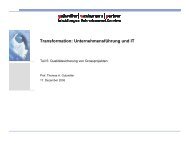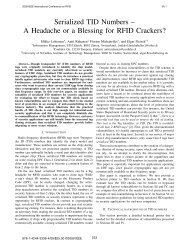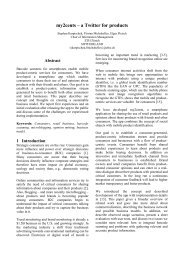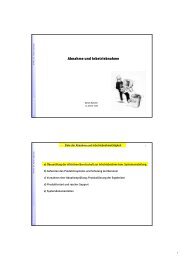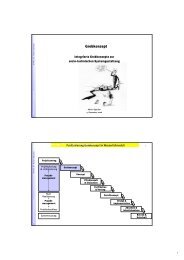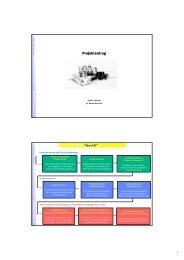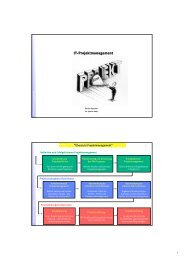Usability Testing of a Facebook Brand Page - Information ...
Usability Testing of a Facebook Brand Page - Information ...
Usability Testing of a Facebook Brand Page - Information ...
Create successful ePaper yourself
Turn your PDF publications into a flip-book with our unique Google optimized e-Paper software.
<strong>Usability</strong> <strong>Testing</strong> <strong>of</strong> a <strong>Facebook</strong> <strong>Brand</strong> <strong>Page</strong><br />
Irena Pletikosa Cvijikj<br />
<strong>Information</strong> Management, ETH Zurich,<br />
Scheuchzerstrasse 7, 8092 Zurich, Switzerland<br />
ipletikosa@ethz.ch<br />
Abstract. Social networks, as a part <strong>of</strong> Web 2.0 technology, provide the<br />
technological platform for users to connect, produce and share content online.<br />
Availability <strong>of</strong> user generated content is encouraging companies to fully engage<br />
with their customers in order to enhance and enrich social media users’<br />
experiences. However, the usage <strong>of</strong> the social media platforms differs from the<br />
more traditional forms <strong>of</strong> a company’s web presence, resulting in challenges <strong>of</strong><br />
applying the traditional usability testing methods. In this paper we analyze this<br />
problem for the context <strong>of</strong> a <strong>Facebook</strong> brand page and propose applying an<br />
iterative usability testing approach over automatically collected data. From the<br />
discussion, we derive implications for usability and social media marketing.<br />
Keywords: social networks, usability testing<br />
1 Introduction<br />
Social networks (SN) have a mediating effect between individuals and society in the<br />
virtual world. As such, they represent a natural technological platform for marketing,<br />
providing access to a large number <strong>of</strong> users. Companies, across all industries are<br />
starting to understand the possibilities <strong>of</strong> social media (SM) marketing. They have<br />
evolved their approach to their customers, <strong>of</strong>fering contact or assistance on a personal<br />
level at any time through social network sites such as <strong>Facebook</strong>, Twitter, etc.<br />
(Gordhamer, 2009). However, how these platforms are being used, what their<br />
potentials are and how consumers interact, remains largely unknown and has yet to be<br />
addressed from different perspectives (Richter et al., 2011).<br />
Availability <strong>of</strong> the user generated content <strong>of</strong> SM platforms is encouraging<br />
companies to fully engage with their customers in order to enhance and enrich SM<br />
users’ experiences. However, the usage <strong>of</strong> the SM platforms differs from the more<br />
traditional forms <strong>of</strong> companies’ web presence resulting in challenges <strong>of</strong> applying the<br />
traditional usability guidelines and methods to this new communication channel.<br />
Classic usability testing methods, involving few participants using a prototype, are<br />
limited when applied to SM. To contribute in this direction we try to answer the<br />
question: How to perform usability testing on a <strong>Facebook</strong> brand page?
2 Related Work<br />
<strong>Usability</strong> can be defined as “the extent to which a product can be used by specified<br />
users to achieve specified goals in a specified context <strong>of</strong> use.” 1 The main usability<br />
principles, as described by Gould and Lewis (1985) are: (1) focus on users and tasks,<br />
(2) empirical measurement, and (3) iterative design. Furthermore, Dumas and Redish<br />
(1993) describe five characteristics <strong>of</strong> usability testing: (1) improving the usability <strong>of</strong><br />
a product/service, (2) the participants represent real users, (3) the participants do real<br />
tasks, (4) observing and recording <strong>of</strong> participants activities, and (5) analysis <strong>of</strong> the<br />
data. Following the described steps should lead to early problem identification and<br />
generation <strong>of</strong> recommendations on how to solve these problems and ultimately<br />
improve the product/system.<br />
The problem <strong>of</strong> usability testing has been studied in depth over different categories<br />
<strong>of</strong> websites. However, content on the social media platforms used for marketing<br />
purposes differs from the traditional web content in terms <strong>of</strong> representing a dialog<br />
between two involved parties, companies and individuals (Boyd and Ellison, 2008).<br />
Furthermore, social media platforms such as <strong>Facebook</strong> and Twitter leave little space<br />
for interface customization. For that reason, practitioners are beginning to address<br />
social media usability from a perspective <strong>of</strong> enhancing the content and activities.<br />
Based on the traditional usability study, Estes et al. (2009) have identified 85 usability<br />
guidelines grouped as (1) content, (2) frequency and timing, (3) voice and tone, (4)<br />
engaging followers and facilitating discussion, (5) pr<strong>of</strong>ile information and design, and<br />
(6) promoting social network presence. Similarly, Fidgeon (2011) advises: (1)<br />
focusing on the users, (2) selecting the appropriate timing, and (3) creating content<br />
suitable for the medium. At the same time, he points out that due to the great diversity<br />
<strong>of</strong> different communities there are no guidelines that could guarantee the success in<br />
this new form <strong>of</strong> communication channel.<br />
To overcome the described challenge, we propose an iterative usability testing<br />
approach based on the automatic data collection that could potentially lead to greater<br />
user satisfaction.<br />
3 Problem Definition<br />
<strong>Usability</strong> testing usually involves usage scenarios in order to determine how people<br />
interact with the product. However, when applied to a <strong>Facebook</strong> brand page, the<br />
interaction assumes dialog between the members <strong>of</strong> the community and the company<br />
which could not be described in a form <strong>of</strong> a task. Furthermore, due to diversity <strong>of</strong> the<br />
online communities, social media guidelines embraced at the planning phase might<br />
not lead to the expected results. To overcome these challenges, we propose iterative<br />
usability testing that would enable strategy refinement in compliance with the actual<br />
characteristics and actions <strong>of</strong> the <strong>Facebook</strong> brand page fans. In the continuation, we<br />
describe the proposed method by answering the questions: (1) which data sources to<br />
use, (2) how to prepare the data for analysis, and (3) how <strong>of</strong>ten to analyze the data.<br />
1<br />
ISO 9241-11, http://www.iso.org/iso/catalogue_detail.htm?csnumber=16883
4 Iterative <strong>Usability</strong> <strong>Testing</strong> <strong>of</strong> a <strong>Facebook</strong> <strong>Brand</strong> <strong>Page</strong><br />
Data Sources. There are two available sources <strong>of</strong> data describing the activities on a<br />
<strong>Facebook</strong> brand page: (1) <strong>Facebook</strong> Insights 2 , and (2) <strong>Facebook</strong> Graph API 3 .<br />
<strong>Facebook</strong> Insights is a platform provided to <strong>Facebook</strong> page administrators to enable<br />
monitoring <strong>of</strong> the activities on the page. It provides information on users, such as<br />
demographics (gender, age, language, etc.) and number <strong>of</strong> fans, as well as details on<br />
the interaction with the page. Data collected through the <strong>Facebook</strong> Insights <strong>of</strong>fers<br />
possibilities for analysis <strong>of</strong> the target audience characteristics. While the<br />
demographics data is useful, since it can’t be obtained from another source, the<br />
interaction data provided by the <strong>Facebook</strong> Insights platform might not be accurate; for<br />
example, number <strong>of</strong> post views is defined as “the number <strong>of</strong> times people have<br />
viewed a News Feed story”. This however can only be counted as the number <strong>of</strong><br />
times the post appeared on someone’s “wall” and there is no guarantee that the post<br />
was seen or read. For that reason, for the interaction evaluation we recommend<br />
implementing a tool that would gather the content shared on the <strong>Facebook</strong> brand page<br />
based on the <strong>Facebook</strong> Graph API.<br />
The <strong>Facebook</strong> Graph API provides access to the <strong>Facebook</strong> social graph via a<br />
uniform representation <strong>of</strong> the objects in the graph (e.g., people, pages, etc.) and the<br />
connections between them. Upon a query, the data can be returned as a <strong>Page</strong> object<br />
containing connections such as Feed, Posts, Photos, etc. A Feed connection represents<br />
a list <strong>of</strong> all Post objects shared on the “wall” containing the following relevant<br />
information: (1) post content, (2) post type, (3) posting user, (4) likes, (5) comments,<br />
(6) application used for posting, (7) creation time and (8) time <strong>of</strong> last interaction. Data<br />
gathered through the Graph API <strong>of</strong>fers possibilities for quantitative and qualitative<br />
analysis with relevance to the usability guidelines referring to the content shared on<br />
the social media platform (Pletikosa and Michahelles, 2011, 2011a). Furthermore, it<br />
provides insights into the users’ reaction in terms <strong>of</strong> posting time (Momentus Media,<br />
2011).<br />
Normalization <strong>of</strong> the Data. Both <strong>of</strong> the data sources provide numbers as an absolute<br />
measure <strong>of</strong> the interaction represented through the number <strong>of</strong> comments, likes, clicks,<br />
views, etc. However, these numbers are related to the total number <strong>of</strong> users at the<br />
observed moment. For that reason, when analyzing the interaction data we<br />
recommend normalization <strong>of</strong> the data with the number <strong>of</strong> fans at the moment, as<br />
described by Pletikosa and Michahelles (2011a).<br />
Iteration Frequency. In terms <strong>of</strong> the iteration frequency there are no many existing<br />
guidelines on what should be the optimal frequency <strong>of</strong> testing and refinements <strong>of</strong> the<br />
usability. Dubach Spiegler (2011) proposes two levels <strong>of</strong> iteration (1) tactical and (2)<br />
strategic control. High-level metrics related to moderator and user activities as a part<br />
<strong>of</strong> the tactical control should be assessed daily in the initial phase <strong>of</strong> the <strong>Facebook</strong><br />
brand page, and not less than weekly once the page is in its operationally mature<br />
phase. Deeper analysis should also be performed on a regular interval to support<br />
strategic control. Since <strong>Facebook</strong> Insights <strong>of</strong>fers monthly aggregated data, for easier<br />
2<br />
<strong>Facebook</strong> Insights, http://www.facebook.com/help/?page=1030<br />
3<br />
<strong>Facebook</strong> Graph API, http://developers.facebook.com/docs/reference/api/
integration <strong>of</strong> the proposed data sources we suggest the iteration frequency <strong>of</strong> one<br />
month for data gathered for strategic control.<br />
5 Discussion and Conclusions<br />
In this paper we have presented a method for usability testing <strong>of</strong> a <strong>Facebook</strong> brand<br />
page. We have addressed two relevant questions: (1) how to overcome the problem <strong>of</strong><br />
data collection in the social media context where the traditional controlled usability<br />
testing might not lead to the expected results, and (2) how <strong>of</strong>ten should the usability<br />
testing be performed in order to enable timely reaction to the possibly changing rules<br />
<strong>of</strong> communication in this noisy medium. The described approach contributes in two<br />
directions: usability testing and social media marketing. From the usability<br />
perspective <strong>of</strong> usability testing it provides a methodology suitable for <strong>Facebook</strong> as a<br />
social media platform which overcomes the discussed challenges. From the social<br />
media marketing perspective, this paper provides insights into how usability concepts<br />
and guidelines could be integrated with a company’s social media marketing strategy<br />
for a <strong>Facebook</strong> brand page. Issues identified by Estes et al. (2009) overlap with those<br />
elaborated in the work <strong>of</strong> Dubach Spiegler (2011). This indicates that social media<br />
marketing practitioners could learn from existing knowledge in the field <strong>of</strong> usability<br />
and user-centered design.<br />
References<br />
1. Gordhamer, S.: 4 ways social media is changing business. Mashable.com,<br />
http://mashable.com/2009/09/22/social-media-business (2009)<br />
2. Richter, D. Riemer, K., vom Brocke, J.: Internet social networking: Research state <strong>of</strong> the art<br />
and implications for Enterprise 2.0. Business & <strong>Information</strong> Systems Engineering (2011)<br />
3. Gould, J.D., Lewis, C.: Designing for usability: key principles and what designers think.<br />
Commun. ACM 28 (3), 300-311 (1985)<br />
4. Dumas, J.S., Redish, J.C.: A practical guide to usability testing. Norwood, NJ: Ablex<br />
Publishing Corporation (1993)<br />
6. Fidgeon, T.: Social media usability: content & activities. Spotless Interactive,<br />
http://www.spotlessinteractive.com/articles/usability-research/usability-testing/social-mediacontent-and-activity.php<br />
(2011)<br />
7. Estes, J., Schade, A., Nielsen, J.: Streams, Walls, and Feeds: 109 Design Guidelines for<br />
Improving Notifications, Messages, and Alerts Sent Through Social Networks and RSS.<br />
Nielsen Norman Group Report, http://www.nngroup.com/reports/streams (2009)<br />
8. Pletikosa Cvijikj, I., Michahelles, F.: Understanding Social Media Marketing: A Case Study<br />
on Topics, Categories and Sentiment on a <strong>Facebook</strong> <strong>Brand</strong> <strong>Page</strong>. 15th MindTrek Conference<br />
and the International Academic Conference (2011)<br />
9. Pletikosa Cvijikj, I., Michahelles, F.: A Case Study <strong>of</strong> the Effects <strong>of</strong> Moderator Posts within<br />
a <strong>Facebook</strong> <strong>Brand</strong> <strong>Page</strong>. 3rd International Conference on Social Informatics (2011a)<br />
10. Momentus Media: Engagement & Interaction - A scientific approach to <strong>Facebook</strong><br />
marketing. Momentus Media Whitepaper, http://momentusmedia.com/blog/?p=899 (2011)<br />
11. Dubach Spiegler E.: Applications and Implications <strong>of</strong> User-Generated Content in Retail,<br />
PhD Thesis, ETH Zurich (2011)



